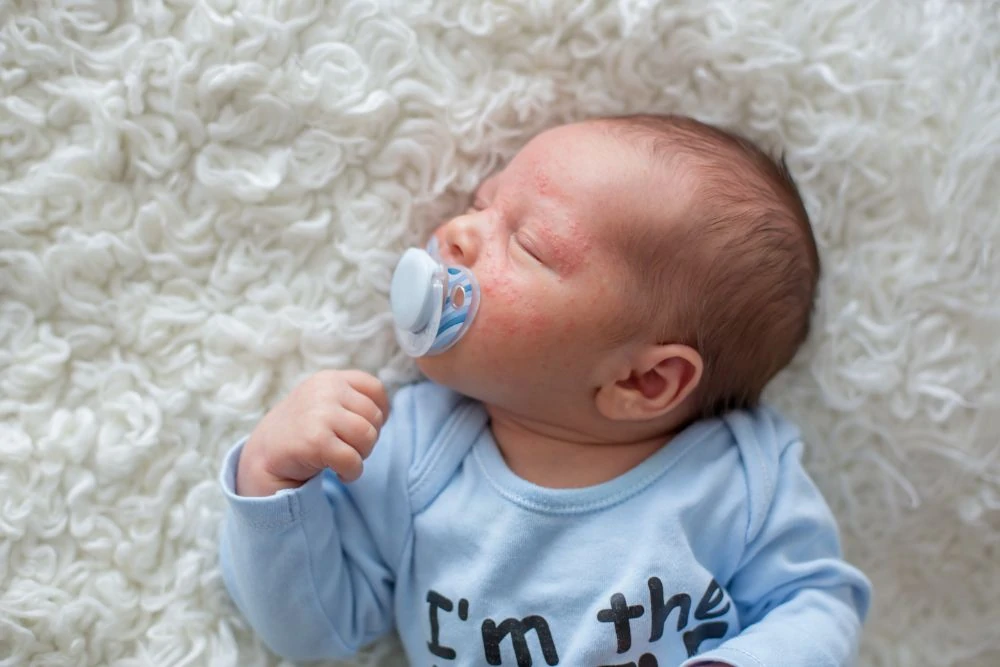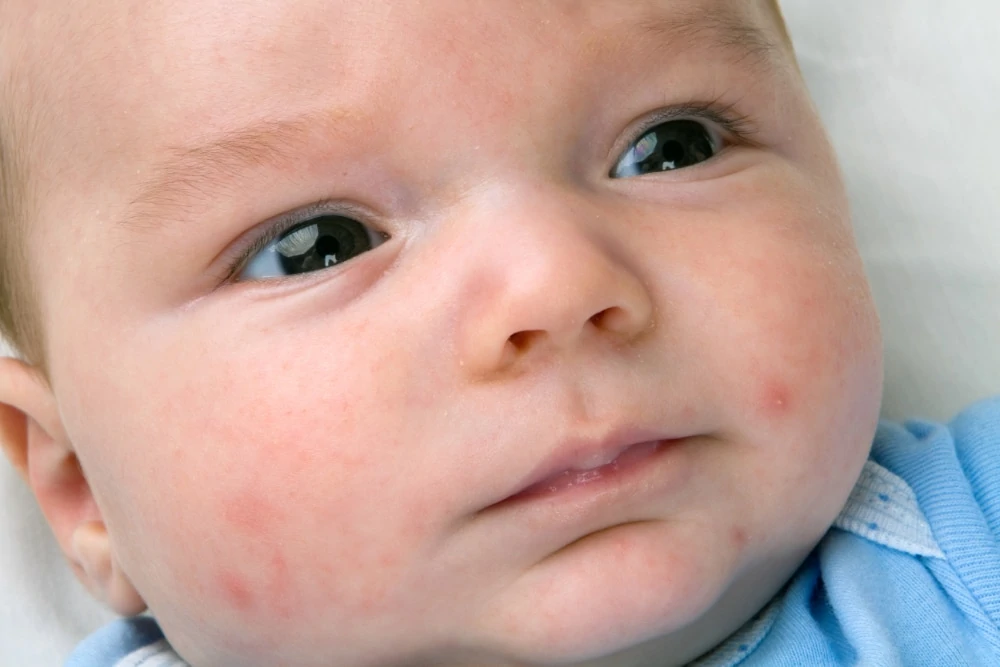Is your baby getting pimple-like bumps on their beautiful little face?
It turns out acne and pimples are not exclusively for teenagers; babies get them too. And no, it doesn’t mean your little one skipped the infant stage and went straight to puberty. Fortunately, there’s no immediate need to seek medical advice. Baby acne is entirely normal, and we’ve experienced it many times with our own children.
In this article, our medical experts will discuss the causes of baby acne, how long it lasts, and what you can do about it.
Key Takeaways
- Baby acne is a common skin condition, with two types: neonatal acne (before 6 weeks) and infantile acne (3-16 months).
- Causes of baby acne include yeast on the skin, hormones, or sensitivity to certain skincare products.
- Neonatal acne usually clears up by 4 months, while infantile acne can last up to two years and may require treatment to prevent scarring.
- Treat baby acne gently by keeping the baby’s face clean, moisturizing, and using scent-free and color-free detergent.
What Is Baby Acne?
Baby acne is a term used to describe an acne-like breakout on your newborn. It is usually a temporary skin condition that causes red or whitish bumps on the face and body.
There are two types of baby acne — neonatal acne and infantile acne.
1. Neonatal Acne
If your baby has acne before 6 weeks of age, doctors refer to it as neonatal acne. About 20% of newborns develop this type, and it primarily affects boys. Some may even have it from the moment they enter the world.
Doctors don’t consider baby acne to be true acne, but we’ll discuss that further below.
Neonatal acne generally appears on the face — on the forehead, cheeks, and chin. Sometimes it runs down the baby’s back or chest.
The affected areas may look bumpy and oily, much like acne looks on an adult. But the breakouts can also appear as small red dots.
2. Infantile Acne
If your baby is between 3 and 16 months, doctors call it infantile acne. This type is less common, affecting approximately 2% of babies. Much like neonatal acne, boys are more likely to develop it.
Infantile acne is a bit different from the baby acne most of us know. Your baby may still have red and whitish bulges, but blackheads and nodules can also appear. These typically surface in clusters, and the bumps may contain pus.
Infantile acne usually runs its course. However, in rare cases, it can be persistent and difficult to get rid of. And unlike neonatal acne, this type is generally viewed as true acne.
Why Does My Baby Have Acne?
This is not easy to answer. Acne, for adults and babies alike, remains somewhat of a mystery. Some experts have chalked it up to hormones. Acne may also be due to sensitivity to a yeast that commonly lives on the skin.
1. Yeast
Yeast, or more specifically, the Malassezia species, is a well-known fungus found on the outer layers of our skin. Yeast can cause an inflammatory response. This, in turn, may cause an acne flare-up.
Some suggest that an overreaction to yeast is the sole cause of neonatal acne. This is also why some experts don’t consider this type to be true acne (1).
2. Skin Care Products
Skin care products are used to combat dry skin. However, they can also trigger acne, especially if they are too oily. A baby’s skin is extremely sensitive, so products must be mild and safe for babies.
Too much oil will block the pores and cause an outbreak of acne.
How Long Will My Baby’s Acne Last?
The duration will depend on the type of acne your baby has. Neonatal acne generally runs its course before 4 months of age. This type usually doesn’t leave any scarring or marks later on.
Infantile acne can be more persistent. Sometimes it can last up to two years, if not more. This may require treatment, especially if it seems tenacious — it can also leave scarring if not treated properly (2).
An Indicator of Future Skin Problems?
It’s almost impossible to tell what issues we might deal with in the future. But there are some clues when we are babies.
If your baby has neonatal acne, there’s no need to worry. Although your child may still develop acne as they grow up, it isn’t due to your pregnancy hormones. There is no connection between baby acne and the acne that teens and adults suffer from.
Infantile acne can sometimes indicate that acne is also in the cards in the future. Some studies revealed this type could lead to more severe cases of breakouts during adolescent years (3).
Similar Conditions
There are several conditions that can cause acne-like breakouts. Fortunately, most of these usually don’t require a visit to the pediatric office.
Here are a few.
1. Eczema
Eczema is a skin condition that causes dry, flaky skin. It appears as rashes, generally on the face and torso, but may spread to other body parts (4).
You can often tell acne and eczema apart by the texture of the breakout. Acne will cause oily, shiny skin, whereas eczema causes dryness and potential peeling.
2. Erythema Toxicum
Erythema toxicum is a relatively common skin condition, affecting about half of newborns. It causes rashes that consist of yellow or whitish bumps surrounded by redness, appearing on the face (5).
In contrast to its complicated name, this condition is not a cause for concern and will disappear on its own.
3. Milia
Milia are tiny white bumps around the nose, eyes, and cheeks. The bulges are dead skin cells trapped underneath the outer layer. This condition is normal and will usually disappear after a couple of days (6).
4. Heat Rash
Heat rashes occur when your baby is too hot. These rashes can cause acne-like breakouts.
However, they tend to show up in sweatier places such as the armpits and neck. They can also appear near the hairline if your little one has a full head of hair.
But unlike acne, a heat rash will subside once the temperature falls.
5. Cradle Cap
Cradle cap is dandruff for babies. This common occurrence causes an oily rash, generally at the crown of the head. The area will look scaly and sometimes red or yellow (7).
Much like baby acne, the exact causes of cradle cap remain a mystery. Experts believe it’s due to an overdose of mother-to-fetus hormones, which causes overproduction of oil glands.
Treatment for Baby Acne
Even though baby acne can look similar to adult acne, you must treat it differently. Keep in mind that infant skin is sensitive, and mishandling it could result in scarring.
Additionally, never try to pop any pimples or squeeze any blackheads. Yes, I know it may be tempting, but by doing so, you can increase the chance of infection and end up scarring the skin.
For all of you pimple-popping mommas, here are a few ways to treat your baby’s acne.
1. Keep Your Baby’s Face Clean
Any residue on your baby’s face can cause irritation and worsen the acne. Whether it’s milk, vomit, or spit-up, make sure you wipe it off.
With some lukewarm water and a cotton pad, gently wash your baby’s face. You can apply some hypoallergenic soap or a soap-free cleanser, which is less irritating to the skin.
Avoid using a coarse washcloth on your baby’s face.
2. Be Gentle
Following bath time, gently pat your baby dry with a towel. Make sure you dry in between all the folds and creases.
Towels can be notoriously harsh on sensitive skin. In fact, they can work as exfoliators. So you can imagine the irritation they might cause to your baby’s acne if you begin to rub them dry.
No matter how soft the towel is, dab or pat gently rather than roughly rubbing.
3. Moisturize
After washing your baby, apply a moisturizing lotion. Avoid using lotion in the areas with acne. Lotion may clog the pores and make acne worse.
4. Try a Humidifier
Dry air can cause acne flare-ups. By using a humidifier, you can add some moisture to the indoor atmosphere. This may be particularly helpful during the cold wintertime when dry skin is more likely.
5. Breast Milk
Breast milk holds many powers. It contains lauric acid, and thus it can act as an antibacterial and anti-inflammatory agent (8).
Take a few drops of breast milk, then wipe it over the acne and leave it to air dry. Some mothers swear by this old wives’ tale remedy.
6. Coconut Oil
Coconut oil is the savior of acne-prone skin. It contains an array of nutrients, including vitamin E and K and lauric acid, among many others (9).
The skin readily absorbs it, quickly restoring lost moisture and making the surface appear supple.
But of course, as with any natural product, consult your pediatrician before the first use.
7. Try a Scent-Free and Color-Free Detergent
The best way to treat baby acne is to prevent it from developing. Sometimes the harsh chemicals and additives found in our detergents can remain in clothes and bedding. If your baby already has sensitive skin, it could cause or worsen their acne.
Avoid using these products, and opt for scent-free and color-free detergent. These are natural and much milder for your baby’s skin.
When to Seek Medical Advice
If your baby has a case of neonatal acne before they are 6 weeks old, there shouldn’t be a need to worry. You can follow some of the treatments above, and it will no doubt run its course. But always consult your pediatrician if you’re in doubt.
Specialists recommend you seek medical advice if your baby develops acne after 6 weeks of age. This is generally to implement the proper treatment to prevent scarring. Doctors will usually treat it with topical creams and oral medicines (10).
Sometimes, infantile acne can indicate a health issue in your baby. Your doctor might carry out blood tests or an X-ray to eliminate other conditions.














